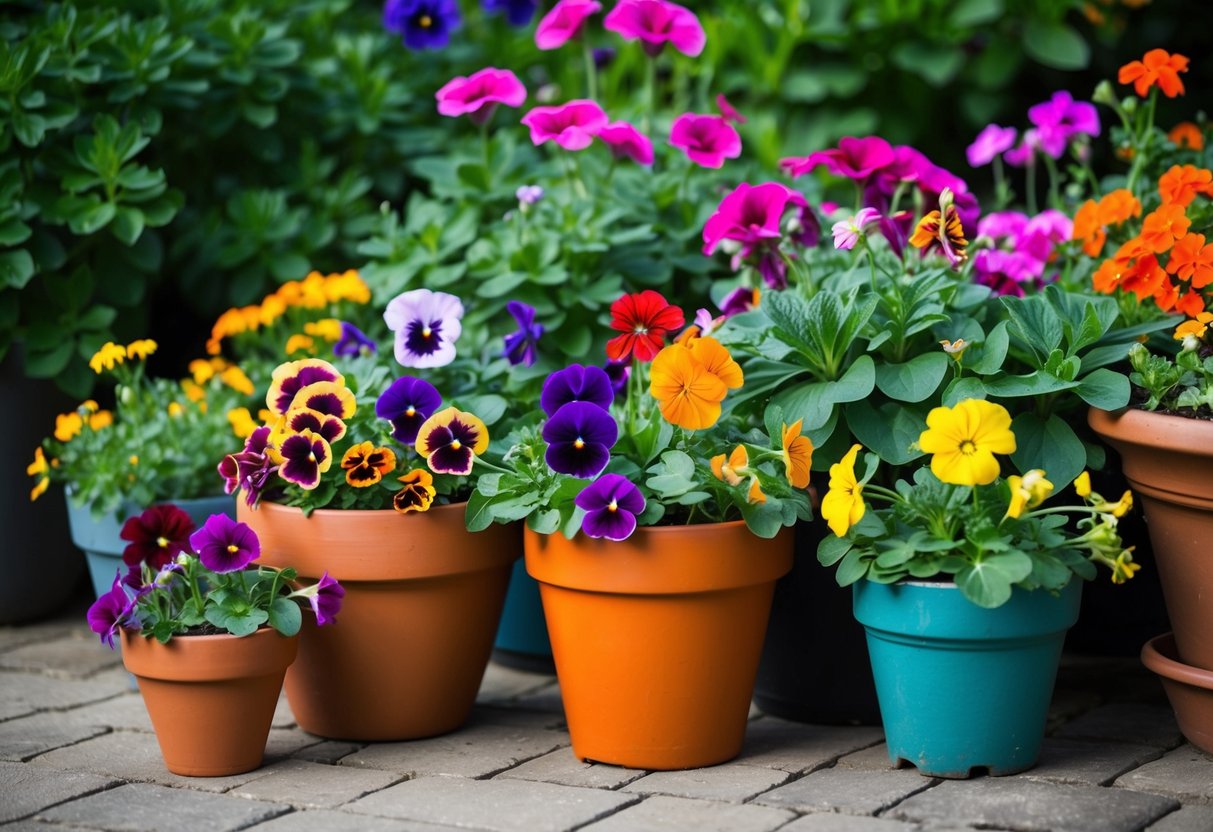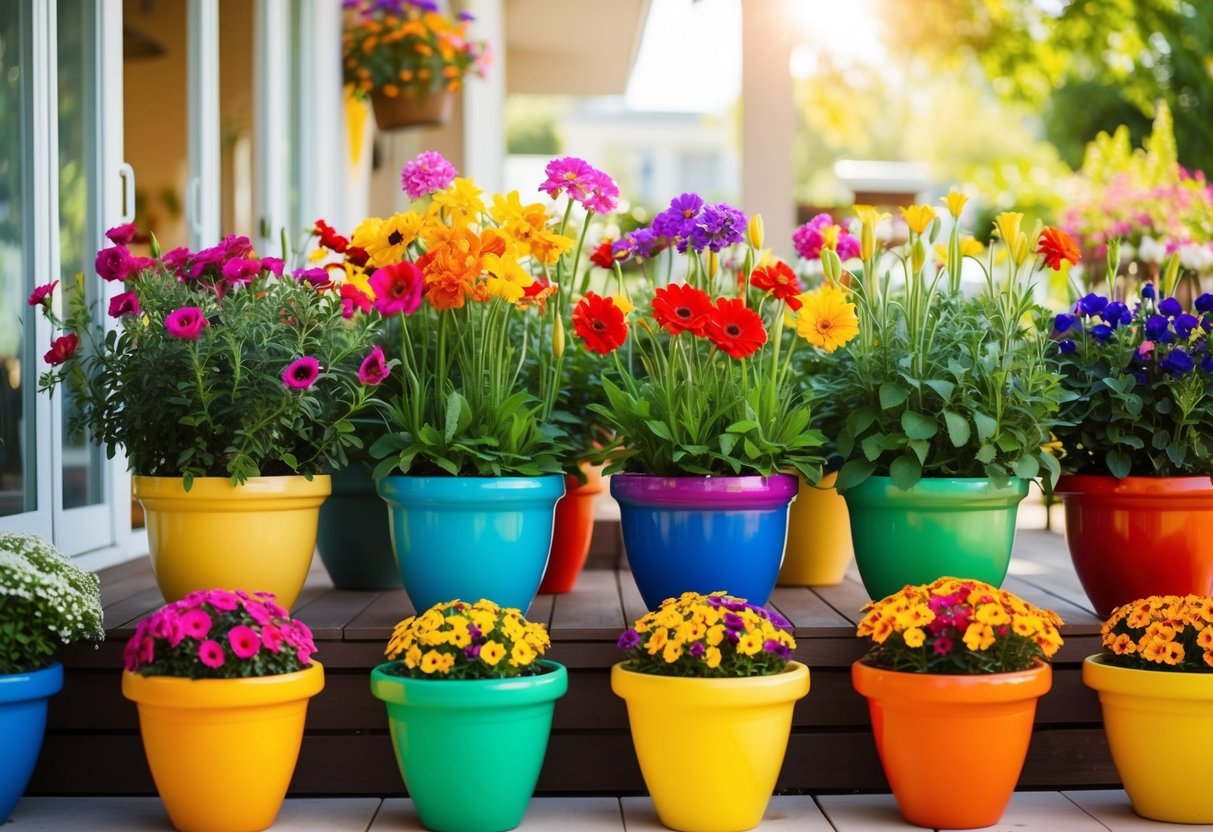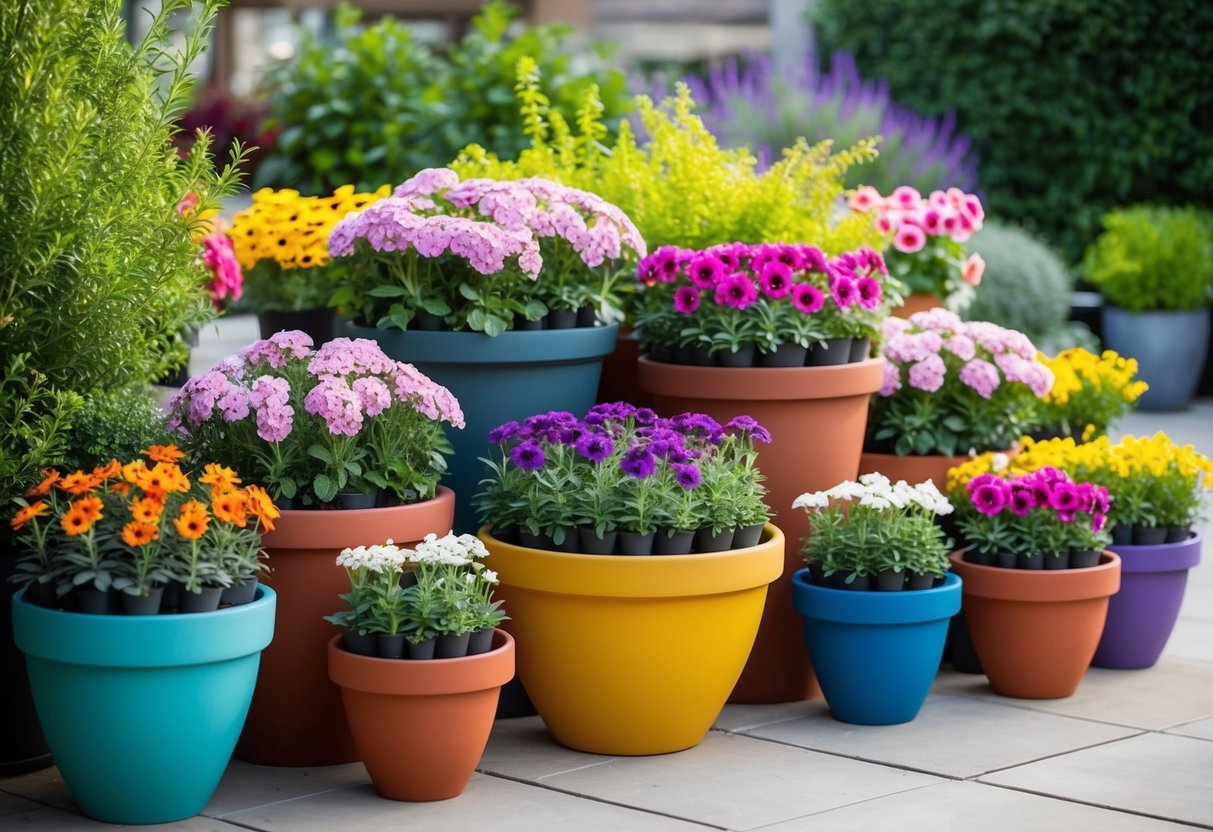What are the Best Flowers to Plant in Pots Outside? A Gardener’s Guide
Creating a vibrant container garden can transform your outdoor space into a colorful oasis. When choosing flowers to grow in pots outside, you have a variety of beautiful options. Petunias and nasturtiums are among the best choices, offering lovely blooms and ease of care. These flowers thrive in sunny spots and bring a pop of color to any patio or balcony.

Petunias are known for their wide range of colors and sizes, making them a versatile choice for any container. They bloom throughout the summer, trailing over pots for a cascading effect. Nasturtiums, on the other hand, boast unique, round leaves and vibrant flowers that can brighten up any space with their cheerful hues.
Sweet potato vines and purslane are also great contenders for outdoor pots. Sweet potato vines provide lush, green foliage and are easy to maintain. Purslane is perfect for sunny spots and has dense foliage that spills beautifully over the edges of planters. By choosing the right flowers, you can enhance your garden and enjoy a long-lasting display of nature’s beauty.
Choosing the Right Flowers for Your Container Garden

When setting up a container garden, selecting the right flowers is essential for vibrant and flourishing displays. Consider the climate, container size, and maintenance needs to ensure your container gardens thrive throughout the season.
Considerations for Selecting Flowers
First, think about sunlight. Determine whether your garden spot gets full sun, partial shade, or full shade. This will affect which flowers will thrive in your containers.
Container size is another factor. Taller plants need larger pots, while smaller blooms can fit in more compact containers. Also, match your flowers to your climate zone. Some flowers tolerate heat, while others are more cold-hardy.
Lastly, plan for watering needs. Some flowers need more water than others, so consider your ability to provide regular care.
Top Annuals for Pots
Annuals are great for pots because they bloom all season long. Nasturtiums are excellent choices for container gardening due to their bright colors and ease of care. These flowers come in shades like red, orange, and yellow, adding a pop of color to your space. Their unusual circular leaves are part of their charm.
Dwarf zinnias stay small and manageable, making them perfect for pots. Their layered petals resemble pom-poms, offering a cheerful look. If you want a cascading effect, sweet alyssum can fit the bill. This low-growing annual comes in clusters of white, pink, and purple flowers, ideal for filling gaps.
Popular Perennials to Grow in Containers
Perennials come back year after year, making them smart picks for container gardens. Cross vines, also called trumpet flowers, can grow tall but with compact containers, they can be managed easily. Their trumpet-shaped flowers are striking and offer a tropical feel to your garden setup.
Another option is the Acalypha, known for its foliage rather than flowers, creating a bold and dramatic look alongside blooms like petunias. If you prefer traditional blooms, dwarf hydrangeas bring beautiful clusters of flowers to your containers and thrive with ample sun and water.
Choosing the right mix of annuals and perennials for containers can ensure a lively and colorful garden throughout the growing season.
Creating Stunning Combinations with Flowers and Foliage

Pairing the right flowers with lush foliage can create eye-catching container gardens. You can mix colors and textures, plant companions together, and use design concepts like fillers, spillers, and thrillers to create stunning pots.
Designing with Color and Texture
Adding various colors and textures to your container garden can make it more appealing. Combine bright colors like red or yellow flowers with dark green foliage to create contrast. Consider plants like coleus or elephant’s ear for bold leaves paired with petunias for bright blooms. Texture also plays a vital role. A mix of broad leaves and delicate flowers, like combining dracaena with trailing petunias, can add depth to your pot. Texture and color together draw the eye and make the arrangement engaging.
Companion Planting in Containers
Companion planting helps plants thrive by pairing those that benefit each other. For example, you might plant marigolds with tomatoes to control pests naturally. In a container setting, you can pair shade-loving plants like hostas with sun-loving plants such as geraniums by placing them strategically for optimal light exposure. This approach also adds variety and interest to your garden, creating a balanced ecosystem in a small space.
Utilizing Filler, Spiller, and Thriller Concepts
Using the filler, spiller, and thriller concept can transform your container garden. Thriller plants, like canna lilies, act as the focal point with their height and vibrant blooms. Filler plants, such as sweet potato vines, provide background and contrast with dense foliage. Spiller plants, like trailing lobelia, drape over the pot’s edges, creating a cascading effect. Choose plants that complement each other, both in height and color, to create a dynamic and captivating display. Integrating all three types offers a balanced and visually appealing container garden.
Essential Care for Potted Flowers

When caring for flowers in pots, it’s important to focus on watering, feeding, and providing the right light and temperature. Each of these factors plays a critical role in keeping container plants healthy and vibrant.
Watering and Feeding Your Container Plants
To keep your potted flowers thriving, water them consistently. Stick your finger about an inch into the soil; if it feels dry, it’s time to water. Be careful not to overwater, as this can lead to root rot.
Use a liquid fertilizer every couple of weeks to provide essential nutrients. Check the instructions on the fertilizer package to know the correct amount to use. A balanced fertilizer works well for most container plants, but some may need specific nutrients.
Always water before applying fertilizer, which helps avoid burning the roots. Keep an eye on how your plants respond, as leaf discoloration can signal over or under-feeding.
Managing Light and Temperature
Most potted flowers need plenty of sunlight, though the amount varies depending on the plant type. Petunias and nasturtiums, for example, enjoy full sun while others, like impatiens, prefer partial shade. Make sure your plants receive the right light by observing where the sun hits your pots throughout the day.
Temperature is also crucial when caring for flowers. Avoid placing plants in areas with extreme temperature swings. If temperatures drop at night or rise drastically during the day, consider using a light blanket for protection or moving pots to a more stable environment.
This attention to light and temperature will help your flowers grow beautifully in their pots outside.
Container Choices and Arrangement Ideas

When choosing containers for your outdoor flowers, it’s important to consider style, space, and functionality. Picking the right pots and planters, thinking creatively in tight spaces, and effectively using hanging baskets and window boxes can elevate your gardening game.
Picking the Perfect Pots and Planters
Picking the right pots is crucial for both aesthetics and plant health. Clay pots are great for a rustic look and they allow good air circulation. Ceramic pots offer various colors and styles, though they can be heavy. If weight is a concern, consider plastic pots. They’re lightweight and come in many designs. Also, ensure your pots have drainage holes to prevent waterlogging.
Material is not the only factor. Size matters too. A pot should be big enough for the plant’s root system but small enough to fit your space. Always think about where you’ll place the pot. For example, choose larger, heavier pots for areas with strong winds to prevent tipping.
Creative Ideas for Limited Space Gardening
Small spaces can still thrive with the right strategy. Use vertical gardening to maximize growth in tight spots. You can install a vertical rack or shelves to place different pots. Containers such as stacking planters allow you to grow multiple plants upward, saving horizontal space.
If you’re tight on ground space, consider railings or wall-mounted planters. They help you utilize every possible inch. Growing herbs or small flowers this way also aids in easy maintenance. Small tiered plant stands are another good idea, offering multiple levels for various pots.
Using Hanging Baskets and Window Boxes Effectively
Hanging baskets are perfect for adding height and variety. They’re great for trailing plants like ivy or petunias. To use them effectively, keep them at eye level so they’re easy to water and maintain. Ensure the hangers are sturdy enough to hold weight and withstand weather changes.
Window boxes offer a convenient and aesthetic way to adorn your home. Fill them with a mix of greenery and colorful flowers for year-round charm. Ensure they’re mounted securely using brackets or window box holders. This system secures them, preventing accidents during strong winds or heavy rain. Consider adding moisture-retaining materials to reduce your watering chores.
Tips for Seasonal and Year-Round Pot Displays

Maximize your garden’s potential by knowing how to transition smoothly between seasons and selecting flowers that provide beauty all year. This will keep your display vibrant and captivating in any weather.
Transitioning Through the Seasons
When planning a pot display, think about how different plants thrive at different times. In spring, start with vibrant pansies and daffodils. As the weather warms, switch to sun-loving blooms like marigolds or zinnias, which thrive during summer container gardens. You can also include some evergreens for year-round appeal.
For fall, mums and asters provide color before winter. In colder months, ornamental kale or hardy cyclamen can brighten your pots. By rotating these plants, you create a seamless flow of new life and color throughout the year. Remember to refresh your soil and add nutrients when changing plants to maintain healthy growth.
Selecting Flowers for Continuous Bloom
Choosing flowers that bloom for long periods keeps your display lively. Petunias and geraniums are great for summer, offering vibrant colors and a continuous show. Combine them with flowers like impatiens for shady spots. In sunny areas, consider hellebore, which can bloom in winter too.
Different flowers have varying sunlight needs, so mix those for sunny and shaded areas. This way, you cover all your bases and have something blooming no matter the weather. Don’t forget to deadhead spent flowers regularly to promote further blooming and maintain tidy pots. This simple maintenance task encourages more blooms, enhancing your flower gardening experience.







